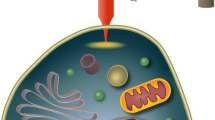Abstract
Dielectric spectroscopy has proved to be a good tool for analyzing the passive electrical properties of biological tissues as well as those of inhomogeneous materials. This technique promises to be a valid alternative to the classical ones based on metabolites to monitor the growth and cell volume fraction of cell cultures in a simple and minimally invasive way. In order to obtain an accurate estimation of the cell volume fraction as a function of the permittivity of the suspension, a simple in silico procedure is proposed. The procedure is designed to perform homogenization from the micro-scale to the macro-scale using simple analytical models and simulation setups hypothesizing the properties of diluted suspension (cell volume fraction less than 0.2). Results obtained show the possibility to overcome some trouble involving the analytical treatment of the cellular shape by considering a sphere with the same permittivity in the quantitative analysis of the cell volume fraction. The entire study is based on computer simulations performed in order to verify the correctness of the procedure. Obtained data are used in a cell volume fraction estimation scenario to show the effectiveness of the procedure.






Similar content being viewed by others
References
Gabriel, C., Gabriel, S., Corthout, E.: The dielectric properties of biological tissues: I. Literature survey. Phys. Med. Biol. 41, 2231–2249 (1996)
Gabriel, S., Lau, R.W., Gabriel, C.: The dielectric properties of biological tissues: II. Measurements in the frequency range 10 Hz to 20 GHz. Phys. Med. Biol. 41, 2251–2269 (1996)
Gabriel, S., Lau, R.W., Gabriel, C.: The dielectric properties of biological tissues: III. Parametric models for the dielectric spectrum of tissues. Phys. Med. Biol. 41, 2271–2293 (1996)
Sihvola, A.: Electromagnetic mixing formulas and applications. The Institute of Electrical Engineers (1996)
Fricke, H.: The electric permittivity of a dilute suspension of membrane-covered ellipsoids. J. App. Phys. 24, 644–645 (1953)
Fricke, H.: The complex conductivity of a suspension of stratified particles of spherical or cylindrical form. J. Phys. Chem. 59, 168–170 (1955)
Schwan, H.P., Lawrence, S.H., Tobias, C.A.: Electrical properties of tissue and cell suspensions. Adv. Med. Biol. Phys. 5, 147–152 (1957)
Schwan, H.P., Bothwell, T.P.: Electrical properties of the plasma membrane of erythrocytes at low frequencies. Nature 178, 265–266 (1956)
Di Biasio, A., Cametti, C.: Effect of shape on the dielectric properties of biological cell suspensions. Bioelectrochemistry 71, 149–156 (2007)
Di Biasio, A., Cametti, C.: Dielectric properties of aqueous zwitterionic liposome suspensions. Bioelectrochemistry 70, 328–334 (2007)
Asami, K.: Dielectric dispersion in biological cells of complex geometry simulated by the three-dimensional finite difference method. J. Phys. D.: Appl. Phys. 39, 492–499 (2006)
Ramos, A.: Improved numerical approach for electrical modeling of biological cell clusters. Med. Biol. Eng. Comput. 48, 311–319 (2010)
Hoeber, R.: Eine Methode die elektrische Leitfäehigkeit im Innern von Zellen zu messen. Arch. Ges. Physiol. 133, 237–253 (1910)
Hoeber, R.: Ein zweites Verfahren die Leitfäehigkeit im Innern von Zellen zu messen. Arch. Ges. Physiol. 148, 189–221 (1912)
Hoeber, R.: Messungen der inneren Leitfäehigkeit von Zellen III. Arch. Ges. Physiol. 150, 15–45 (1913)
Harris, C.M., Todd, R.W., Bungard, S.J., Lovitt, R.W., Morris, J.G., Keli, D.B.: Dielectric permittivity of microbial suspensions at radio frequencies: a novel method for the real-time estimation of microbial biomass. Enzyme Microb. Technol. 9, 181–186 (1987)
Noll, T., Biselli, M.: Dielectric spectroscopy in the cultivation of suspended and immobilized hybridoma cells. J. Biotechnol. 9, 187–198 (1998)
Ducommun, P., Kadouri, A., von Stockar, U., Marison, I.W.: On-line determination of animal cell concentration in two industrial high-density culture processes by dielectric spectroscopy. Biotechnol. Bioeng. 77, 316–323 (2002)
Cannizzaro, C., Gugerli, R., Marison, I., von Stockar, U.: On-line biomass monitoring of CHO perfusion culture with scanning dielectric spectroscopy. Biotechnol. Bioeng 84, 597–610 (2003)
Ansorge, S., Esteban, G., Ghommidh, C., Schmid, G.: Monitoring nutrient limitations by online capacitance measurements in batch and fed-batch CHO fermentations. Conference Proceedings to the 19th ESACT Meeting: Cell Technology for Cell Products, Vol. 84, pp 723–726. Springer , Dordrecht/NL (2007)
Schnelle, T., Müller, T., Fuhr, G.: Dielectric single particle spectroscopy for measurement of dispersion. Med. Biol. Eng. Comput. 37, 264–271 (1999)
Kun, S., Ristic, B., Peura, R.A., Dunn, R.M.: Real-time extraction of tissue impedance model parameters for electrical impedance spectrometer. Med. Biol. Eng. Comput. 37, 428–432 (1999)
Kun, S., Peura, R.A.: Selection of measurement frequencies for optimal extraction of tissue impedance model parameters. Med. Biol. Eng. Comput. 37, 699–703 (1999)
Bordi, F., Cametti, C., Gili, T.: Dielectric spectroscopy of erythrocyte cell suspensions. A comparison between Looyenga and Maxwell–Wagner–Hanai effective medium theory formulations. J. Non-Cryst. Solids 305 (1), 278–284 (2002)
Chelidze, T.: Dielectric spectroscopy of blood. J. Non-Cryst. Solids 305(1), 285–294 (2002)
Aleksander, P.S., Stiz, R.A., Bertemes-Filho, P.: Frequency-domain reconstruction of signals in electrical bioimpedance spectroscopy. Med. Biol. Eng. Comput. 47, 1093–1102 (2009)
Asami, K.: Characterization of heterogeneous systems by dielectric spectroscopy. Prog. Polym. Sci. 27, 1617–1659 (2002)
Wagner, K.W.: Erklärung der Dielectrischen Nachwirkungsvorgänge auf Grund Maxwellscher Vorstellungen. Arch. Electrotech. 2, 371–387 (1914)
Maxwell, J.C.: Treatise on Electricity and Magnetism. Clarendon, Oxford (1891)
Debye, P.: Polar Molecules. Dover, New York (1954)
Van der Vorst, H.A.: Bi-CGSTAB: a fast and smoothly converging variant of bi-cg for the solution of nonsymmetric linear systems. SIAM J. Sci. Stat. Comput. 2, 631–644 (1992)
Acknowledgments
This work is part of the research project: Assessment techniques of three-dimensional (3D) cell growth and morphology in microgravity using electromagnetic diffraction, realized through the Italian Space Agency (ASI) co-financing.
Author information
Authors and Affiliations
Corresponding author
Rights and permissions
About this article
Cite this article
Frezza, F., Mangini, F., Muzi, M. et al. In silico validation procedure for cell volume fraction estimation through dielectric spectroscopy. J Biol Phys 41, 223–234 (2015). https://doi.org/10.1007/s10867-014-9374-8
Received:
Accepted:
Published:
Issue Date:
DOI: https://doi.org/10.1007/s10867-014-9374-8




